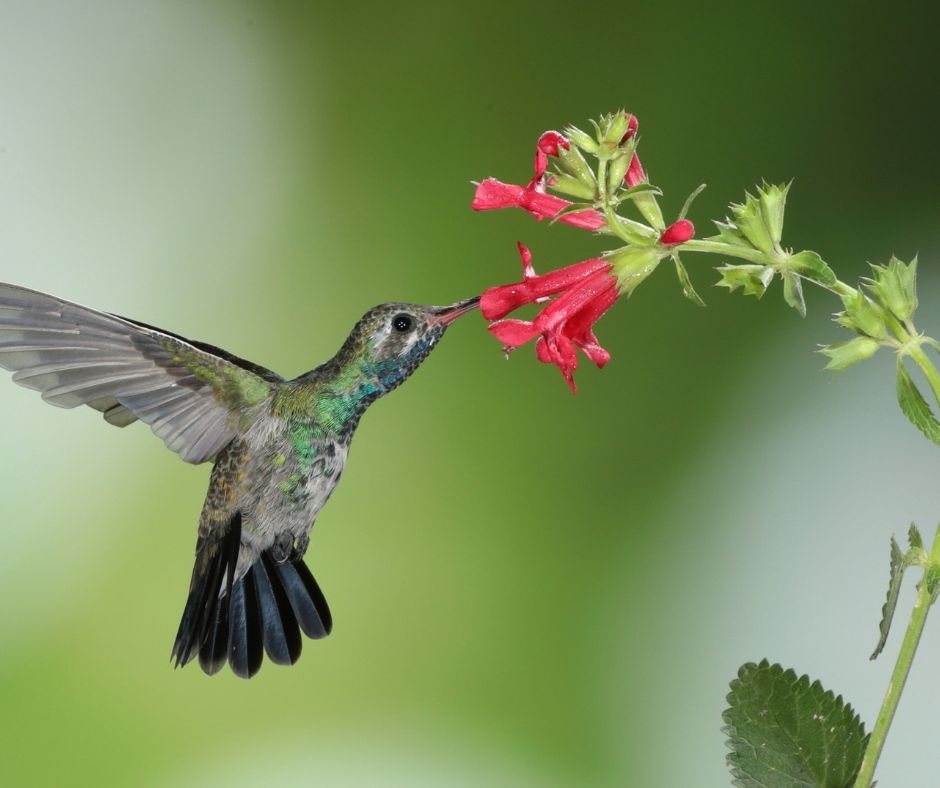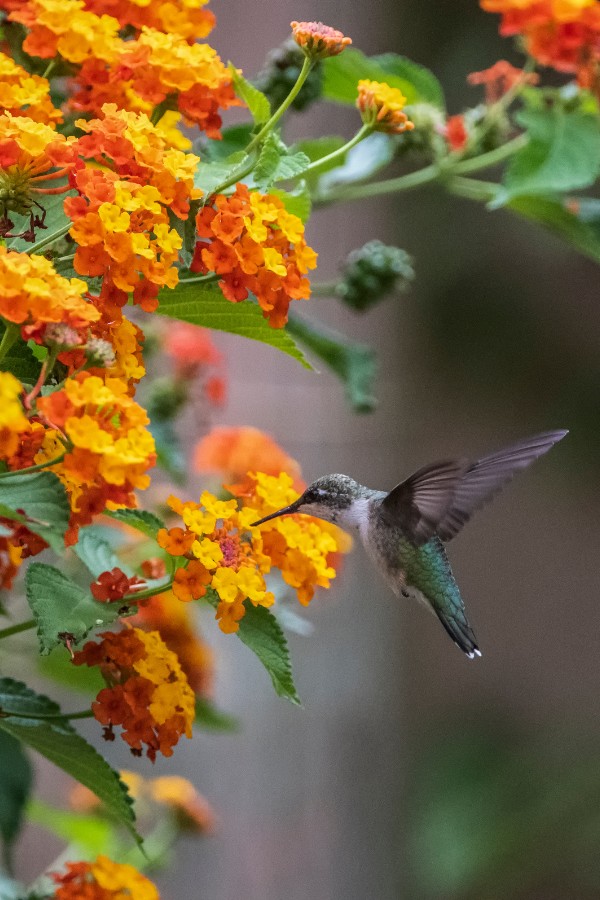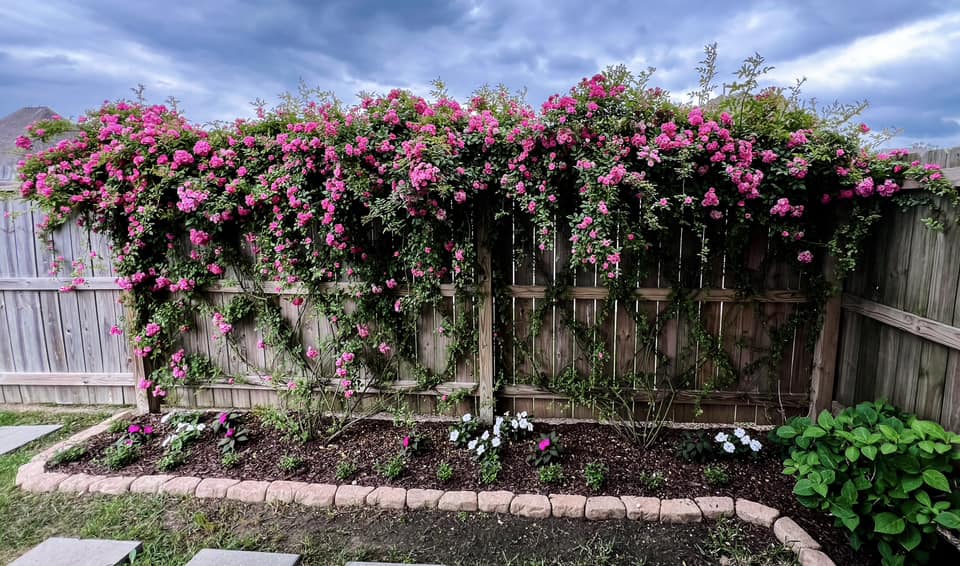Did you know a that hummingbird’s heart beats a staggering 1,260 times per minute? Or that their tiny wings can flap around 80 times per second?
Hummingbirds are true marvels of nature, with iridescent colors, acrobatic flight, and fearless spirit. It’s no wonder why avid birders and garden enthusiasts alike do whatever it takes to turn their yards into hummingbird sanctuaries!
If you’re looking to do the same, Louisiana Nursery has you covered with all the best plants, feeders, and tips to get started.

Hummingbirds of Louisiana
Ruby-Throated Hummingbirds
This is Louisiana’s only breeding hummingbird. You can spot males by their fiery red throats and the females with their plainer green and white plumage. You’ll see them every year from around spring through the early fall.
Winter Visitors
Less common, but still good to lookout for western species like Rufous, Allen’s, Black-chinned, and others. While most will migrate to Mexico and Central America, some western hummingbirds choose to spend winter in the milder Louisiana climate.

When Are Hummingbirds Most Active in Louisiana?
While you can expect most activity from March through September, there are certainly peak parts of that season and exceptions to the rule. The most visible months for Ruby Throated hummingbirds are March-April & August-September as they migrate through & from Louisiana. In-between these months, they are busy nesting (the purpose of migrating of course)! In my experience, the fall after nesting is when hummingbirds are most eager for a tasty meal.
If you see hummingbirds from November- February, it’s likely a western species mentioned before! The Audubon Society has a great seminar on these migration patterns.
Attracting Hummingbirds with Louisiana-Friendly Plants
Nectar Powerhouses
Unlike other birds, hummingbird’s incredible fast wings mean they expend lots of energy just by moving about. You’ll want to use plants that satisfy their appetites with high-nectar content.
- Salvia
- Abutilon
- Honeysuckle
- Bottlebrush
- Trumpet Vine
- Mandevilla
- Dipladenia
- Hibiscus
- Shrimp Plant
- Firebush
- Pentas
- Lantana

Think Red
Hummingbirds are drawn to red, so choose plenty of flowers in fiery shades. However, they should in addition to or part of your nectar-filled selections. Nectar content is king.
Tubular Blooms
Hummingbirds’ long, slender beaks are perfectly adapted to reach into tubular flowers. Unlike bees and other insects who utilize large, flat flowers as a landing pad (think sunflowers), hummingbirds can almost float while drinking nectar.
Staggered Bloom Times
Plant varieties that bloom at different times to provide hummingbirds a consistent food source all season long. Especially important to have blooms in that March-April and August-September timeframe.
Beyond Flowers
Offer water sources like birdbaths, shallow dishes, or misters for bathing opportunities. Small trees and shrubs like ligustrum, crape myrtles, hawthorns, sweet olives, and banana shrubs all provide resting places to perch and watch over their food sources.
Feeders: The Supplement to Your Garden
Placement
While your flowers are an invitation to hang around, feeders are the best way to see all the action!
The Baton Rouge Audubon Society puts it simply:
“The main reason to hang a hummingbird feeder is so that you can see the birds. It’s not to keep the birds alive – they will do quite well without you, feeding on natural nectar and insects.”
With that in mind, you’ll want to place it in a spot visible to you and easy enough to access. Near windows or screened-in porches are great spots, so long as they’re out of reach from cats on the hunt or raccoons looking to steal some nectar.
Since feeders must be occasionally cleaned, a shady spot will lower maintenance by staying cooler, thus slowing down spoilage. If you plan on taking pictures & videos, keep lighting in mind when hanging your feeder.
Finally – to reduce competition among hummingbirds – hang multiple feeders out of sight from one another. Hummingbirds are fiercely territorial.
Styles
We offer a wide range of hummingbird feeders in different styles, but the vast majority are red, no-drip (leak-proof) inverted bottles. Try opening the feeder and see if cleaning or refilling is easy enough.
Nectar
Our nectar selection includes large, pre-mixed solutions and inexpensive concentrates with added vitamins for bird-health, most options having no artificial colors. Store-bought nectars can be stored for much longer periods of time, meaning you can save with bulk-bottles. While still more expensive than DIY, our concentrate creates 48 fl. Oz. for just $3.99.
Even still, DIY can save you some cash to buy more bird feeders! Just mix 1/4th cup of sugar with each cup of water and boom, you’ve got your own nectar solution. We recommend only making enough to fill feeders for the month, as this solution spoils quickly and can damage bird health.
Cleaning
You should clean feeders more regularly than you think! This is a food source that is prone to mold in our climate. If you see murkiness or cloudy stains in your feeder, empty it completely and clean with a weak bleach. Allow the bleach to sit for 20-30 minutes and rinse thoroughly with hot water.
To encourage regular cleaning and reduce waste, only fill your feeder about halfway rather than to the top.


